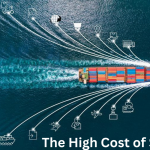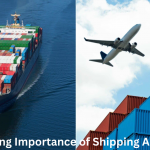Domestic shipping plays a crucial role in the U.S. economy, ensuring that goods move efficiently between manufacturers, retailers, and consumers across the country. With vast distances between production centers and end-users, and the increasing prevalence of e-commerce, the domestic shipping landscape is more dynamic than ever. This article will explore the different facets of domestic shipping in the U.S., including the key methods of transportation, logistics, challenges, regulatory factors, and emerging trends.
Key Methods of Domestic Shipping
Domestic shipping encompasses several primary methods of transportation, each of which plays a critical role in moving goods across the country:
- Trucking: The backbone of U.S. domestic shipping, trucks account for over 70% of freight transportation within the country. The U.S. has a vast network of highways, making trucking the most flexible mode of transportation for domestic shipments. Trucks range from small delivery vehicles to large 18-wheelers capable of transporting heavy loads across long distances. Many businesses rely on trucking for short-distance and last-mile deliveries, especially in urban and rural areas that are not easily accessible by other modes of transport.
- Rail: Rail freight plays a key role in moving large quantities of goods across long distances. It is highly efficient for bulk shipments such as raw materials, coal, agricultural products, and chemicals. Rail transport offers a cost-effective option for heavier, non-perishable goods, although it is typically slower than other methods. The U.S. has a well-established rail infrastructure, with major freight rail operators like Union Pacific and BNSF playing a vital role in national logistics.
- Air Freight: Though air freight accounts for a smaller percentage of domestic shipping, it is crucial for the transportation of high-value, time-sensitive goods such as electronics, medical supplies, and perishable items. Air shipping is the fastest mode of transportation, but it is also the most expensive. Major players like FedEx, UPS, and DHL provide comprehensive air freight services across the U.S., supported by a network of regional airports and distribution hubs.
- Waterways (Inland Shipping): The U.S. has an extensive system of navigable rivers and waterways, such as the Mississippi River, which are used for moving bulk commodities, especially agricultural products and heavy industrial goods. Barges and ships transport these items more efficiently in terms of cost per ton, though this method is slower and limited to regions with access to navigable water routes.
- Intermodal Shipping: Intermodal shipping combines multiple transportation methods, typically rail and truck, to move goods across the country. Intermodal containers allow for seamless transitions between modes, improving efficiency and reducing handling times. This method has gained popularity due to its cost-effectiveness and lower environmental impact.
Logistics of Domestic Shipping
Domestic shipping involves a complex web of logistics services and infrastructure, all designed to ensure that goods are delivered on time, in good condition, and at a reasonable cost. The primary components of domestic shipping logistics include:
- Warehousing and Distribution Centers: Warehouses and distribution centers are critical for storing goods before they are shipped to their final destinations. These facilities are often located near major transportation hubs to facilitate efficient distribution across the country. With the growth of e-commerce, the demand for strategically placed distribution centers has increased, particularly in densely populated regions.
- Supply Chain Management: Effective supply chain management is essential to ensure that domestic shipping operations run smoothly. This involves managing inventories, coordinating transportation schedules, and ensuring compliance with regulations. Companies use sophisticated logistics software to monitor shipments, track orders in real-time, and optimize routes to reduce delays and costs.
- Last-Mile Delivery: Last-mile delivery refers to the final stage of the shipping process, where goods are delivered to the end customer. This aspect of domestic shipping has become increasingly important due to the growth of e-commerce. Companies such as Amazon, FedEx, and UPS have invested heavily in last-mile logistics to meet rising consumer demand for fast, reliable deliveries.
Challenges Facing Domestic Shipping in the U.S.
While the domestic shipping industry is vital to the U.S. economy, it faces several significant challenges:
- Infrastructure Strain: The U.S. transportation infrastructure, particularly highways and bridges, is aging and in need of repair. Congestion on major highways leads to delays, increased fuel consumption, and higher costs for shippers. Improving infrastructure is a key focus for policymakers, but large-scale projects require significant time and investment.
- Driver Shortage: One of the biggest challenges in the trucking industry is the ongoing shortage of qualified drivers. The demand for truck drivers has increased in recent years due to the rise in e-commerce and freight volumes, but recruitment has not kept pace. Long hours, the need for specialized training, and tough working conditions have contributed to the shortage, which in turn affects delivery times and shipping costs.
- Fuel Costs and Environmental Concerns: Fuel costs are a significant factor in domestic shipping expenses, particularly for long-haul trucking and air freight. Price volatility in the oil market can create uncertainty for shippers and logistics companies. Additionally, there is growing pressure on the industry to reduce carbon emissions and adopt more environmentally sustainable practices. This has led to an increased focus on electric vehicles, alternative fuels, and more efficient shipping methods.
- Regulatory Compliance: The U.S. domestic shipping industry is heavily regulated, with rules governing everything from driver working hours to environmental standards. The Federal Motor Carrier Safety Administration (FMCSA) oversees the trucking industry, setting limits on driving hours to ensure safety, while the Environmental Protection Agency (EPA) sets emissions standards. Compliance with these regulations adds another layer of complexity and cost to domestic shipping operations.
Trends Shaping the Future of Domestic Shipping
The future of domestic shipping in the U.S. will be shaped by several emerging trends:
- E-Commerce Growth: The rapid growth of e-commerce has transformed the domestic shipping landscape, creating demand for faster, more flexible delivery options. Consumers now expect next-day or even same-day delivery, driving companies to invest in advanced logistics solutions and new delivery models, such as drone deliveries and autonomous vehicles.
- Technological Innovation: Technology is playing an increasingly important role in domestic shipping. The use of data analytics, artificial intelligence (AI), and machine learning allows companies to optimize routes, predict demand, and reduce delivery times. Autonomous trucks, drones, and robots are also being developed to revolutionize the way goods are delivered.
- Sustainability Initiatives: With growing awareness of climate change and environmental concerns, the shipping industry is under pressure to reduce its carbon footprint. Companies are investing in electric trucks, renewable energy, and more efficient logistics systems to cut emissions. Additionally, some states are implementing stricter regulations on emissions, pushing the industry to adopt greener practices.
- Supply Chain Resilience: The COVID-19 pandemic exposed vulnerabilities in global and domestic supply chains, highlighting the importance of building resilience. Companies are increasingly looking to diversify their supply chains, invest in local manufacturing, and use predictive analytics to avoid disruptions.
Conclusion
Domestic shipping in the U.S. is a dynamic and essential part of the economy, involving multiple modes of transportation, complex logistics, and ever-evolving challenges. As consumer expectations continue to rise and technological innovations reshape the industry, companies must remain adaptable and forward-thinking. From improving infrastructure to embracing sustainable practices, the future of domestic shipping will be defined by how well the industry responds to these challenges and opportunities.
FAQs
1. What is domestic shipping?
Domestic shipping refers to the transportation of goods within a country’s borders. In the U.S., it involves moving products between different states or regions, utilizing various methods like trucks, trains, planes, and ships.
2. What is last-mile delivery?
Last-mile delivery refers to the final stage of the shipping process, where goods are delivered from a transportation hub or warehouse to the end customer’s doorstep. It’s crucial for e-commerce businesses and significantly impacts customer satisfaction.
3. How does intermodal shipping work?
Intermodal shipping uses multiple forms of transportation—like trucks, rail, or ships—within the same journey. Goods are transported in containers that can easily be transferred between different modes of transport, optimizing costs and time.
4. How does the U.S. shipping industry handle perishable goods?
Perishable goods like food or medicine are typically shipped using temperature-controlled vehicles and storage facilities. Air freight is often used for faster deliveries of time-sensitive perishables. Companies like FedEx and UPS have specialized services for such goods.
5. What role do logistics companies play in domestic shipping?
Logistics companies manage the planning, implementation, and coordination of goods movement. They oversee warehousing, transportation schedules, compliance with regulations, route optimization, and real-time tracking to ensure efficient deliveries.
6. What is the cost-effective shipping option for heavy goods?
Rail freight is the most cost-effective method for transporting heavy or bulk goods over long distances. It is particularly useful for items like raw materials, coal, and agricultural products.




